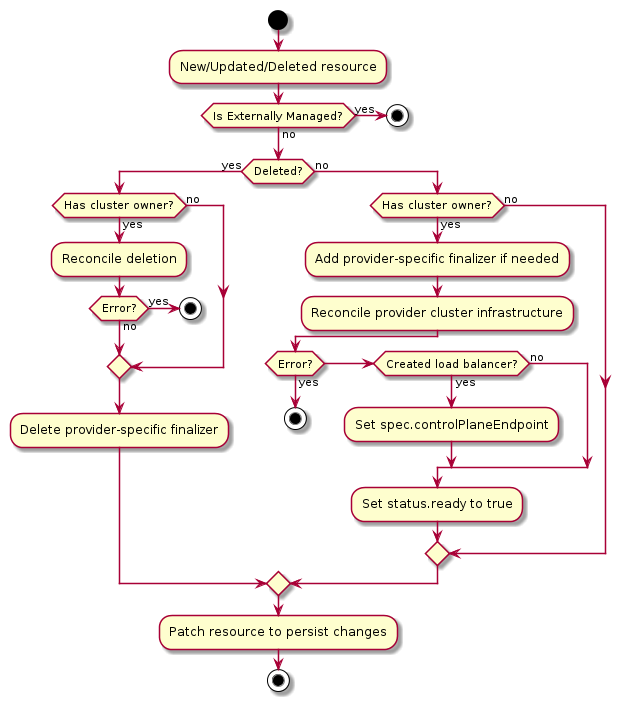Cluster Infrastructure Provider Specification
Overview
A cluster infrastructure provider supplies whatever prerequisites are necessary for running machines. Examples might include networking, load balancers, firewall rules, and so on.
Data Types
A cluster infrastructure provider must define an API type for “infrastructure cluster” resources. The type:
- Must belong to an API group served by the Kubernetes apiserver
- May be implemented as a CustomResourceDefinition, or as part of an aggregated apiserver
- Must be namespace-scoped
- Must have the standard Kubernetes “type metadata” and “object metadata”
- Must have a
specfield with the following:- Required fields:
controlPlaneEndpoint(apiEndpoint): the endpoint for the cluster’s control plane.apiEndpointis defined as:host(string): DNS name or IP addressport(int32): TCP port
- Required fields:
- Must have a
statusfield with the following:- Required fields:
ready(boolean): indicates the provider-specific infrastructure has been provisioned and is ready
- Optional fields:
failureReason(string): indicates there is a fatal problem reconciling the provider’s infrastructure; meant to be suitable for programmatic interpretationfailureMessage(string): indicates there is a fatal problem reconciling the provider’s infrastructure; meant to be a more descriptive value thanfailureReasonfailureDomains(failureDomains): the failure domains that machines should be placed in.failureDomainsis a map, defined asmap[string]FailureDomainSpec. A unique key must be used for eachFailureDomainSpec.FailureDomainSpecis defined as:controlPlane(bool): indicates if failure domain is appropriate for running control plane instances.attributes(map[string]string): arbitrary attributes for users to apply to a failure domain.
- Required fields:
Behavior
A cluster infrastructure provider must respond to changes to its “infrastructure cluster” resources. This process is typically called reconciliation. The provider must watch for new, updated, and deleted resources and respond accordingly.
The following diagram shows the typical logic for a cluster infrastructure provider:

Normal resource
- If the resource is externally managed, exit the reconciliation
- The
ResourceIsNotExternallyManagedpredicate can be used to prevent reconciling externally managed resources
- The
- If the resource does not have a
Clusterowner, exit the reconciliation- The Cluster API
Clusterreconciler populates this based on the value in theCluster‘sspec.infrastructureReffield.
- The Cluster API
- Add the provider-specific finalizer, if needed
- Reconcile provider-specific cluster infrastructure
- If any errors are encountered, exit the reconciliation
- If the provider created a load balancer for the control plane, record its hostname or IP in
spec.controlPlaneEndpoint - Set
status.readytotrue - Set
status.failureDomainsbased on available provider failure domains (optional) - Patch the resource to persist changes
Deleted resource
- If the resource has a
Clusterowner- Perform deletion of provider-specific cluster infrastructure
- If any errors are encountered, exit the reconciliation
- Remove the provider-specific finalizer from the resource
- Patch the resource to persist changes
RBAC
Provider controller
A cluster infrastructure provider must have RBAC permissions for the types it defines. If you are using kubebuilder to
generate new API types, these permissions should be configured for you automatically. For example, the AWS provider has
the following configuration for its AWSCluster type:
// +kubebuilder:rbac:groups=infrastructure.cluster.x-k8s.io,resources=awsclusters,verbs=get;list;watch;create;update;patch;delete
// +kubebuilder:rbac:groups=infrastructure.cluster.x-k8s.io,resources=awsclusters/status,verbs=get;update;patch
A cluster infrastructure provider may also need RBAC permissions for other types, such as Cluster. If you need
read-only access, you can limit the permissions to get, list, and watch. The AWS provider has the following
configuration for retrieving Cluster resources:
// +kubebuilder:rbac:groups=cluster.x-k8s.io,resources=clusters;clusters/status,verbs=get;list;watch
Cluster API controllers
The Cluster API controller for Cluster resources is configured with full read/write RBAC
permissions for all resources in the infrastructure.cluster.x-k8s.io API group. This group
represents all cluster infrastructure providers for SIG Cluster Lifecycle-sponsored provider
subprojects. If you are writing a provider not sponsored by the SIG, you must grant full read/write
RBAC permissions for the “infrastructure cluster” resource in your API group to the Cluster API
manager’s ServiceAccount. ClusterRoles can be granted using the aggregation label
cluster.x-k8s.io/aggregate-to-manager: "true". The following is an example ClusterRole for a
FooCluster resource:
apiVersion: rbac.authorization.k8s.io/v1
kind: ClusterRole
metadata:
name: capi-foo-clusters
labels:
cluster.x-k8s.io/aggregate-to-manager: "true"
rules:
- apiGroups:
- infrastructure.foo.com
resources:
- fooclusters
verbs:
- create
- delete
- get
- list
- patch
- update
- watch
Note, the write permissions allow the Cluster controller to set owner references and labels on the
“infrastructure cluster” resources; they are not used for general mutations of these resources.